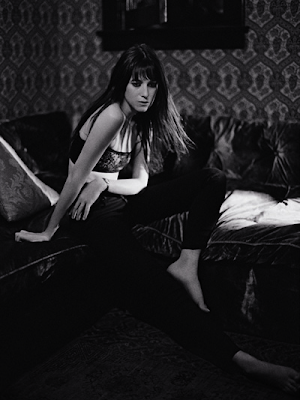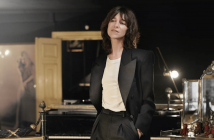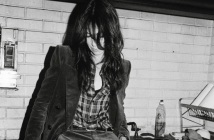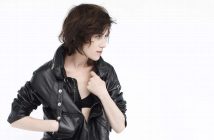Charlotte Gainsbourg, photographiée par Paul Jasmin, sera dans le numéro #62 de V Magazine, en kiosques le 3 novembre 2009.
Voici deux photos en avant-première !
Styliste : Heidi Bivens
Credits: Soutien Gorge par Balenciaga par Nicolas Ghesquiere, Jeans par Stella McCartney
Charlotte Gainsbourg in Los Angeles, August 2009
THE DEVIL INSIDE – V Magazine, November 2009
CHARLOTTE GAINSBOURG SURVIVED A NEAR-DEATH EXPERIENCE ONLY TO BECOME THE LATEST LEADING LADY TO GO TO HELL AND BACK FOR LARS VON TRIER
In Antichrist, the latest film from Danish maverick Lars von Trier, the actress, chanteuse, and model Charlotte Gainsbourg performs a horrendous litany of extremes: attempting suicide and murder, committing torture and self-mutilation. And yes, let’s be clear right away, the rumors are true: she cuts off her clitoris with scissors—in close-up. But ever since the mindblower of a movie stunned viewers at the Cannes Film Festival in May, where Gainsbourg won the award for best actress, the French performer has maintained a steady nonchalance towards the X-rated sex, wild violence, and other outré shenanigans that appear in the movie.
“It wasn’t upsetting. That was the weird thing about it,” Gainsbourg says in a smooth, subdued, British-inflected tone. “It should have been upsetting, but I actually had a lot of masochistic pleasure in all the suffering,” she admits.
Antichrist follows Gainsbourg’s character and her husband (Willem Dafoe) as they venture to their cabin in the woods to grapple with the death of their infant son. The story is told in four parts, moving from crippling grief to crushing pain to horrific rage to maniacal self-destruction—much of those feelings laying squarely on Gainsbourg’s delicate shoulders. Like many of von Trier’s previous films (Breaking the Waves, Dancer in the Dark, Dogville), it’s the central woman who undergoes a visceral and prodigious amount of suffering, while men—rational and selfish—end up contributing to it.
Gainsbourg has shouldered much in her decades in the public eye. As the daughter of ’60s British sex symbol Jane Birkin and France’s hard-living pop icon Serge Gainsbourg, the 38-year-old Parisian was a celebrity at 13. Her 1985 duet with her dad, “Lemon Incest,” launched her career, whether she was ready or not. When accepting the best actress award at Cannes, she thanked her father, whom she said, “would have been proud of me, and proud of being shocked.”
But Gainsbourg’s interest in Antichrist wasn’t simply about provocation. The film came at a pivotal moment for both the actress and her director. Von Trier had endured an immobilizing bout of depression, using the film as therapy to exorcise his own psychosexual demons, while Gainsbourg was hungry to get back to work after several months of recovery following a waterskiing accident and subsequent brain surgery.
“I realized how close I had been to dying,” she recalls, “which makes you kind of a sissy, because you’re then afraid of everything. Each time you have a minor headache, you think you’re going to die.”
By the time of filming Antichrist, though, she wasn’t as worried about her health; in fact, quite the other way around, she was fearless. “The extremes are so high, and the emotions are so extreme,” she says of the film. “Of course I was willing to go that way, that fast.”
And as the passive love-interest in films such as The Golden Door or The Science of Sleep or the sad wife in I’m Not There or 21 Grams, Gainsbourg has had few opportunities to play a demented villain or hysterical vamp. “Very often, people see me as somebody who is tranquil and soft, so I have not been asked to put myself in such a state, to be able to go from horror to drama to a sex scene,” she says. “The range was so wide that it was really exciting.”
Initially, another French actress, Casino Royale’s Eva Green, wanted the part, but her agent, according to von Trier, thought better of it. “Then to my rescue came Charlotte,” says von Trier. “The first thing she said to me was that she was dying to get the part, and I was dying to get rid of the part. So that was fine.”
Accusations of misogyny and sadism have dogged von Trier over the years; Dancer in the Dark star Björk once wrote that the director needs women to provide his work soul, and hates them for it, “so he has to destroy them during filming.” But Gainsbourg’s initial fears about the project quickly dissipated after a few meetings with von Trier. “It became very clear and very easy,” she says.
In fact, her model for the character was von Trier himself—who famously suffers from panic attacks and won’t fly in airplanes. “From the very start, I had the impression that I was playing him,” she says. To understand the turmoil of the character, for example, von Trier showed Gainsbourg Internet clips of people having panic attacks on planes and telling her about his own physical symptoms. The most helpful was just watching him, and his way of shaking,” she says.
Production, however, was no piece of cake. While Gainsbourg wasn’t bothered by reaching an inner place where she could realistically drill a bolt into Dafoe’s leg or violently try to fuck him, the scenes themselves were so strong that she didn’t have to “perform madness,” as she puts it. Rather, most difficult was that she had no idea what the final result of her performance would be, because von Trier stretched her in different directions for every shot. “If I was supposed to cry in a scene, he would make me go into hysterics and then try laughing,” she says. “In the end, I didn’t know what I had done, because each take was so different.”
As for the clitoridectomy, she was unfazed. “The act itself didn’t mean much,” she says. “It was more to do with the suffering and the guilt. I referred to that end point as wanting to die.”
Having survived a cerebral hemorrhage and von Trier’s nightmare vision, Gainsbourg is effortlessly moving on. She’s at work on another, albeit very different film about grief—an adaptation of Australian writer Judy Pascoe’s Our Father Who Art In a Tree, about a mother of four who loses her husband. And she’s also collaborating with Beck on a new album, tentatively titled IRM, so named for the magnetic resonance imaging machines that were so prevalent in her life following the waterskiing accident.
“In the end, I kind of liked the sounds, because they were reassuring,” says the actress, once again finding solace in the macabre. “They were kind of like a lullaby.” Anthony Kaufman
Photography Paul Jasmin
Styling Heidi Bivens
Bra Balenciaga by Nicolas Ghesquière
Jeans Stella McCartney
Watch Gainsbourg’s own
Antichrist is out now from IFC Films.
IRM is out in January 2010 from Because Music





